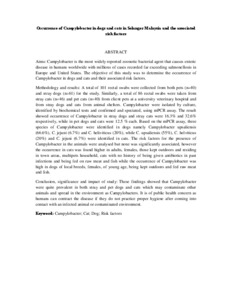Citation
Goni, Mohammed Dauda and Abdul Aziz, Saleha and Dhaliwal, Gurmeet Kaur and Zakaria, Zunita and Bitrus, Asinamai Athliamai and Muhammad, Ibrahim Jalo and Aung, Wint Wint and Mohamed, Mohamed Abdelrahman and Aliyu, Abdulrasheed Bello
(2017)
Occurrence of Campylobacter in dogs and cats in Selangor Malaysia and the associated risk factors.
Malaysian Journal of Microbiology, 13 (3).
pp. 164-171.
ISSN 1823-8262; ESSN: 2231-7538
Abstract
Aims: Campylobacter is the most widely reported zoonotic bacterial agent that causes enteric disease in humans worldwide with millions of cases recorded far exceeding salmonellosis in Europe and United States. The objective of this study was to determine the occurrence of Campylobacter in dogs and cats and their associated risk factors.
Methodology and results: A total of 101 rectal swabs were collected from both pets (n=40) and stray dogs (n=61) for the study. Similarly, a total of 86 rectal swabs were taken from stray cats (n=46) and pet cats (n=40) from client pets at a university veterinary hospital and from stray dogs and cats from animal shelters. Campylobacter were isolated by culture, identified by biochemical tests and confirmed and speciated, using mPCR assay. The result showed occurrence of Campylobacter in stray dogs and stray cats were 16.3% and 32.6% respectively, while in pet dogs and cats were 12.5 % each. Based on the mPCR assay, three species of Campylobacter were identified in dogs namely Campylobacter upsaliensis (66.6%), C. jejuni (6.7%) and C. heliviticus (20%), while C. upsaliensis (55%), C. helviticus (20%) and C. jejuni (6.7%) were identified in cats. The risk factors for the presence of Campylobacter in the animals were analysed but none was significantly associated, however the occurrence in cats was found higher in adults, females, those kept outdoors and residing in town areas, multipets household, cats with no history of being given antibiotics in past infections and being fed on raw meat and fish while the occurrence of Campylobacter was high in dogs of local breeds, females, of young age, being kept outdoors and fed raw meat and fish.
Conclusion, significance and impact of study: These findings showed that Campylobacter were quite prevalent in both stray and pet dogs and cats which may contaminate other animals and spread in the environment as Campylobacters. It is of public health concern as humans can contract the disease if they do not practice proper hygiene after coming into contact with an infected animal or contaminated environment.
Download File
![[img]](http://psasir.upm.edu.my/60603/1.hassmallThumbnailVersion/Occurrence%20of%20Campylobacter%20in%20dogs%20and%20cats%20in%20Selangor%20Malaysia%20and%20the%20associated%20risk%20factors.pdf)  Preview |
|
Text (Abstract)
Occurrence of Campylobacter in dogs and cats in Selangor Malaysia and the associated risk factors.pdf
Download (38kB)
| Preview
|
|
Additional Metadata
Actions (login required)
 |
View Item |

